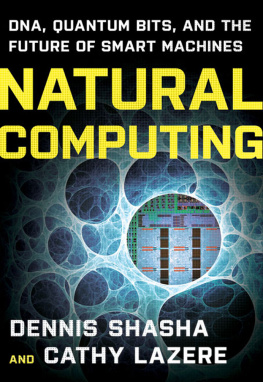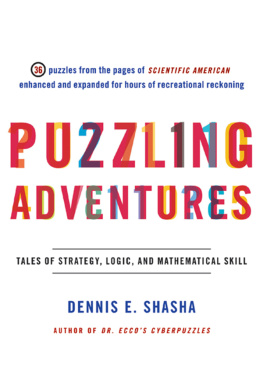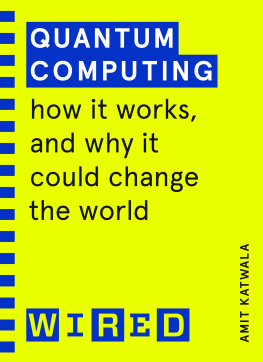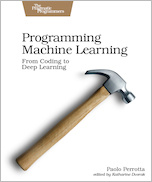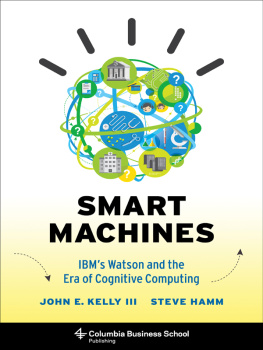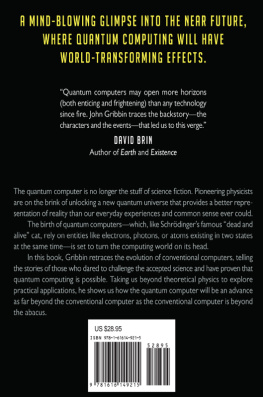W. W. NORTON & COMPANY
For information about permission to reproduce selections from this book, write to Permissions, W. W. Norton & Company, Inc.,
500 Fifth Avenue, New York, NY 10110
Shasha, Dennis Elliott.
Natural computing: DNA, quantum bits, and the future of smart machines / Dennis Shasha and Cathy Lazere.1st ed.
p. cm.
Includes bibliographical references.
ISBN: 978-0-393-07719-3
1. Natural computation. 2. Artificial intelligence. 3. Computer scientists. I. Lazere, Cathy A. II. Title.
QA76.9.N37S33 2010
006.3dc22
W. W. Norton & Company, Inc.
500 Fifth Avenue, New York, N.Y. 10110
www.wwnorton.com
W. W. Norton & Company Ltd.
Castle House, 75/76 Wells Street, London W1T 3QT
PREFACE
When we began this book, we expected to talk to scientists who were solving problems on the frontier of what is possible in computing. We expected them to describe new computer architectures and a variety of new software techniques. The fifteen scientists featured in Natural Computing control spacecraft from millions of miles away, embed intelligence in smart bacteria, or build computers to run as fast as a million desktops combined. They work on the most challenging applications in science, engineering, and even finance. We expected this diversity, but we didnt expect the common vision that has emerged across all of these fields: the future of computing is a synthesis with nature .
There are three major strands to this vision.
First, biological thinking has inspired new ways to do digital computing. This hasnt happened yet in your word processor or in data centers, but it has occurred in applications that are pushing technology to its most interesting limits. For example, computers control spacecraft throughout flight and after landing. Manual repair of onboard hardware, once in flight, is often impossible; but innovative spacecraft engineers propose designing machines that will repair themselves. If youre not in an engineering field, you may not appreciate what a change in thinking this approach represents. Instead of building a high-precision machine that can handle every possibility, designers construct a machine that will adapt itself to possibilities the designers cannot even imagine.
Although there is some debate about how to realize this new design philosophy, many of the scientists profiled in this book suggest that evolution or some form of learning should be involved. At first glance, evolution and learning may seem very different. Evolution works across many generations and organisms, while learning and adaptation occur in a single organism. Conceptually, however, they are very similar: try something and see how it works; then respond to feedback by trying something new that has a chance to be better. We associate learning with conscious improvement, but evolution occurs subconsciously, chemically, or even metabolically. For purposes of survival, however, learning and evolution have the same effect.
Many applications are based on evolutionary techniques. In Natural Computing , a surfer dude turned mathematical financier uses evolutionary algorithms to figure out when to buy or sell US Treasury bonds. A professor analyzes the safety of a missile defense system by checking how well safety procedures adapt to failure. In these instances, evolution, learning, and adaptation are linked.
Second, biological entities may replace silicon. Computing built on DNA or bacterial cells is nearly free (billions of bacteria need just a little sugar water to grow), and DNA computing also has a massively parallel capacity. One day, living bacteria rather than silicon electronics may compute inside our bodies or inside microfactories. Harnessing life in this way will require the development of an entirely new paradigm of computing. No longer will a human hand design computers to work reliably for several years, give them universally known names, and install them in air-conditioned splendor.
Computers made of bacteria or viruses come by the million, have no names, and are provincialthey communicate only with their neighbors. They also fail often. Getting them to do something useful is daunting and might seem impossible, but it must be possible because we already have what mathematicians call an existence proof: humans are composed of about 100 trillion cells and we are able to run, think, and love, even though none of our individual cells can do those things.
Third, new applications may require rethinking the underlying physics of computation. Simulating protein folding or breaking codes requires thousands of processors to coordinate their work. Because communication through switches and computer memory is slow compared with the speed of transistors, such a strategy works best when there is little communication between faraway processors. For that reason, the fastest digital machines on the planet are designed to move information as little as possible.
For example, a multi-millionaire inventor has embarked on the design of a machine to simulate the behavior of proteins. To do this, his hardware moves the information concerning each atom in the protein to very specific places within the active circuitry. At those places, information is combined with corresponding information about neighboring atomsall without returning to the computers slow memory. The payoff may be speeding up computation by a factor of 1,000, enough to accelerate a task that would normally require as much as a century to one that could be completed in less than 100 days.
Another designer, much less well funded, has constructed a computing device whose main computational element is a piece of foam attached to 25 wires. Measuring the electric current could offer a method to simulate the differential equations that characterize a whole host of continuous scientific problems, from the prediction of star trajectories in galaxies to the propagation of pigmentation on butterfly wings. This extended analog computer turns computing completely on its head. Instead of calculating an answer using 1s and 0s and arithmetic in a digital computer, it measures an answer.
You may find yourself feeling affection for these machines. Instead of the hard metal engines that do calculations or send e-mails or play chess, you will see machines that are more humanthey repair themselves, attempt extremely hard problems, and sometimes make mistakes. These are computational devices that may one day set your broken bones, maintain the stability of bridges, or perhaps even help you breathe underwater.
In writing Natural Computing , we encountered a constellation of ideas that could change the world decisively for the better. Each chapter in this book describes a unique path to discovery. We hope you enjoy reading the stories of these risk-seeking adventurers as much as we enjoyed writing them.

